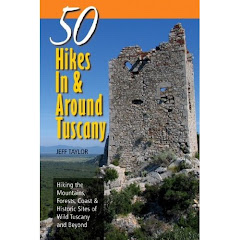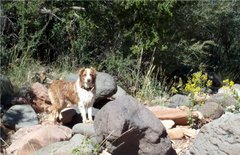Distance: 5.8 miles round trip (9.4 km)
Elevation: 1,615 - 2,680 feet (492 - 817 m)
Difficulty: Moderate
Time of Year: September - May
Located in northern San Diego County, just east of the City of Poway, is a beautiful hike in the dry chaparral habitat called Iron Mountain. This 2680 foot peak in the foothills of the Mountain Empire, offers spectacular 360 degree panoramic views of all of San Diego County and out all the way to Mexico and the San Gabriel Mountains north of Los Angeles. It's a quick, steep climb to the summit, but the views are well worth it. In addition, the aromatic scents of sage, wildflowers, and chaparral make you almost forget about the traffic of Southern California. Well almost, as this hike is very popular and crowded with the locals.
To get to the trailhead, head to the City of Poway on I-15 and then take the Poway Road Exit. Drive through the city and out of town to the east until coming to the intersection with CA-67. The Iron Mountain Trailhead is located at the Park-and-Ride right on the eastside of the junction. It is a large parking lot and well signed. There is no fee to park here. The trail begins on a wide fire road heading straight toward the ridge, with the actual summit obvious to the right of the trail. Be aware that this trail is entirely exposed to the sun, which might be very pleasant in the mild weather of winter, but could be scorching over 100 degrees come summer.
The trail will branch shortly into two segments, but whichever one you take does not matter, since they rejoin about 1/2 mile later. If you take the right one, you will get more shade in the morning sun than the most exposed left branch. The trails head through the lower chaparral vegetation type known as "sage scrub". The silvery coastal sage and Artemsia both have very aromatic leaves.
 |
| View of Cuyamaca Peak (right) from the saddle |
After the trails reconverge, the route climbs up to a saddle and trail junction. The Ellie Lane trail heads off to the left, while the Iron Mountain Trail stays to the right. From this saddle, you get your first views of the Laguna Mountains and Cuyamaca Peak to the east, while the Pacific Ocean is visible to the west.
 |
| A view to the southwest toward San Diego |
The trail skirts along the eastern slope of Iron Mountain, climbing slowly at first, but then the switchbacks begin. The trail is rocky and begins to steepen, but is not particularly difficult. The views are growing ever expansive to the east. After a ways, the trail reaches another saddle, giving you the next opportunity to see the ocean. Then, begins the steepest part of the trail, as a relentless series of switchbacks head up the northern face of the mountain.
 |
| Downtown San Diego and the Coronado Islands |
As you look up, you keep thinking you are almost at the top, but it is higher than you think. Nonetheless, once you reach the summit, the 360 degree views make this climb well worth it. From the summit, you can see Downtown San Diego to the southwest, with the Coronado Islands of Mexico offshore beyond them. You can see El Cajon to the south and the Laguna Mountains to the southeast.
 |
| Lake Poway |
Lake Poway sits down below you to the southeast and Cuyamaca Peak rises as the highest mountain to the east. Further north, you can make our Volcan Mountain near Julian, the Santa Rosa Mountains beyond that, and Mount San Jacinto way off to the northeast. Palomar Mountain dominates the view to the north, with its broad rounded summit ridge blocking most of the view of anything beyond that. But, if you look carefully, you can make out parts of the San Gabriel Mountains 100 miles to the north.
 |
| Panoramic View of the Mountain Empire |
The curve of the coastline and a couple of the Channel Islands are visible offshore to the northwest. Directly to the west is Torrey Pines, while slightly southwest of that is Mount Soledad and La Jolla. After your have taken in your fill of the views of southern California, retrace your steps back.
 |
| Palomar Mountain to the north |






























































